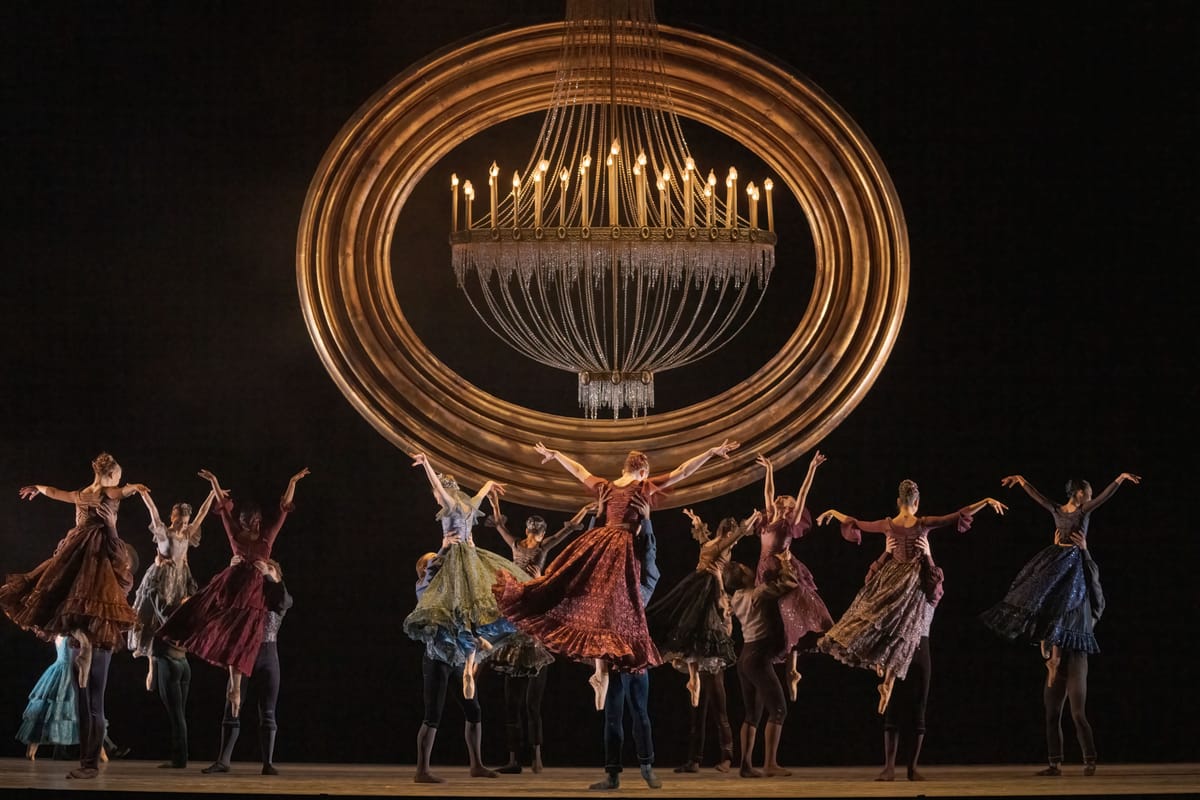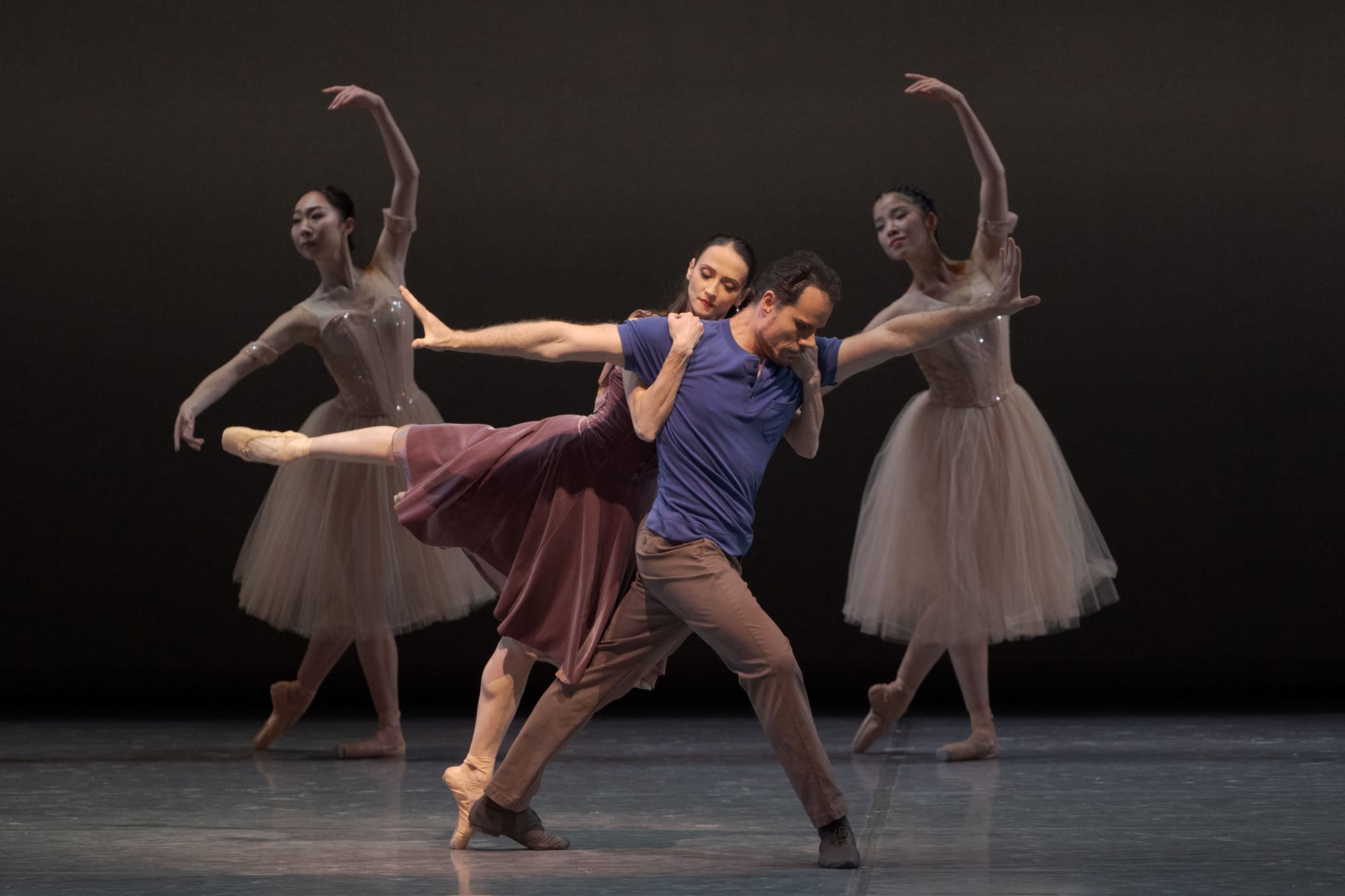An Anti-heroine

“Emma Bovary”, “Passion”
The National Ballet of Canada
Four Seasons Centre for the Performing Arts
Toronto, Canada
November 15, 2023
The National Ballet of Canada’s 2023-2024 season opener featured two distinctly different, yet complimentary works. First was James Kudelka’s “Passion”, a plotless ballet that nonetheless depicts different types of relationships and romantic love. Second was the world premiere of “Emma Bovary” - a modern take on Gustave Flaubert’s seminal 1856 novel “Madame Bovary” choreographed by Helen Pickett. Both ballets contrast the formality and rigidity of culturally sanctioned relationships versus the exhilarating freedom (and risks) of relationships that fall outside those norms.
“Emma Bovary” is the first ballet that the NBoC has commissioned from Pickett. She brought a team of past collaborators James Bonas (stage director) and Peter Salem (music), both who worked with her on “The Crucible” for the Scottish Ballet. Canadian set and costume designer Michael Gianfrancesco and lighting designer Bonnie Beecher round out the creative team. Changing the title from “Madame Bovary” to “Emma Bovary” says much about this production that centers around Emma’s internal world. The title identifies her as an individual, rather than a wife. Since Hope Muir assumed the role of NBoC artistic director in 2022, she has shown a commitment to creating space and opportunities for more female and BIPOC choreographic voices. This has been an important shift and the consistency with which it is applied ensures that new works like “Emma Bovary'' go beyond mere tokenism. The fact that this ballet presents the perspective of a real woman (rather than an ethereal creature) with human desires and flaws is a natural extension of this shift in programming.
The ballet is just one act and runs for 60 minutes, so Pickett wisely chose not to present the narrative in a linear or literal manner. Rather than cramming in every detail from the novel, she tells the story in broad strokes, highlighting key turning points and depicting their effects on Emma’s psyche.
In this performance, Emma was performed by first soloist Jenna Savella. Savella has a flair for the dramatic and excels in contemporary works. Here she built on her dramatic skills that were showcased when she created the title role in Robert Binet’s “Orpheus Alive” in 2019. Her characterization of Emma is that of a woman who does not find fulfillment through traditional channels and is forced to look for it elsewhere. Unfortunately, she ends up looking in all the wrong places, frivolously spending beyond her means on luxury goods and running into the arms of a shameless philanderer. Once she has a taste of decadence, she cannot stop herself. Throughout the ballet, she stands out in bright teal dresses, a sharp contrast to the darker and more muted costumes of the other dancers. A full length mirror often stands on the side of her scenes, a symbol of her vanity and yearning for a life of glamor. In one of the most striking moments early in the ballet just after getting married, she climbs atop the kitchen table and screams at the top of her lungs. There are also moments where she floats above the stage using suspension wires. The movement vocabulary assigned to her is organic, sensual and compulsive, at times using modern dance gestures to express her inner turmoil.
In contrast, her husband Charles Bovary (danced by Jack Bertinshaw), is stiff and buttoned up. He watches her explore movement, but does not partake. Bertinshaw portrays Charles as a sympathetic character - not a bad guy, just extremely boring and incapable of understanding his wife’s needs.
Monsieur Lheureux, a duplicitous merchant and moneylender, understands Emma’s needs all too well, using this to his advantage and driving her to financial ruin. Kota Sato is brilliantly sinister in the role. His black vinyl trench coat and the dramatic lighting also add to the effect. He preys on her insecurities and convinces her to fill the void inside her with material things. In one scene, he seduces her with fancy furniture selling her one extravagant chair after another. The chairs initially seem like an odd choice to depict her consumerism, but in the final scene as her world falls apart, the chairs reappear, stacked upon each other in a chaotic and oppressive manner that is visually quite striking.
Emma’s lover, Rodolphe, danced by Harrison James, is believably charming. Her stern mother in law was danced by Alexandra MacDonald. She runs a tight ship in the family home only to have her own screaming moment where she lets out a guttural cry of frustration. The scene suggests that she once experienced desires similar to Emma’s but was never able to act on them.
There are surrealist elements as well. Emma and Charles’ daughter, Berthe, is presented here as a skeletal puppet that requires 3 puppeteers to maneuver. The baby’s initial appearance is jarring and creepy initially, but the puppeteers are able to create very natural movements and soon the puppet baby is integrated into the action of the ballet. Her alien appearance seems to portray Emma’s feelings of detachment from her child. In another vignette towards the end, the corps de ballet come out with grotesque pig head masks. The ballet begins with an elegant ballroom with couples gliding gracefully across the floor, all dizzying choreography and dreamy music. However, towards the end of the ballet, the chandelier is unstable and swinging around while Emma is visited by her husband, her lover, the moneylender and her priest who swirl around her only to abandon her.
“Emma Bovary” succeeds on many fronts with interesting visual effects and engaging choreography. Although impressionistic in approach, it gets the focal points of the story across. On the one hand, it is a critique on the narrow and limited roles assigned to women in Western society. On the other hand, it is also a commentary on the hypocrisy of the bourgeoisie and the dangers of a misplaced focus on consumerism and upward mobility. In this sense, it feels relevant to our times. This is likely a work that will reveal more with subsequent viewings.

Kudelka’s “Passion”, created for Houston Ballet in 2013 was acquired by the NBoC for Piotr Stanczyk’s retirement. In his 25 years with the company, Stanczyk has worked closely with Kudelka who was his artistic director for the first 7 years of his career. Set to Beethoven’s piano concerto in D (aptly played by pianist Andrei Streliaev), this is a plotless work that contrasts a corps de ballet and featured couple with classical movements and a leading couple that appear in a more contemporary style of choreography. As the contemporary couple, Stanczyk and Svetlana Lunkina wear simple, everyday attire and her hair is loose. The classical group, led by technical whizzes Harrison James and Calley Skalnik, wear long romantic tutus (the women) and formal black pants, vests and white shirts (the men). Presumably, they convey different types of love – courtly and formal versus impulsive and passionate. However, this does not totally come across on stage. While there are moments of pretty pictures and intricate partner work, the ballet is not among Kudelka’s strongest. The half hour long work feels flat, the dynamics in the music not reflected anywhere in the steps. It hits one tone for the entire time. Stanczyk showed his clean technique and steady partnering skills, but one wished for a more dramatic role for this farewell performance. Stanczyk steadily proved himself a remarkable dance actor over the years and the gravitas he brought to so many roles will certainly be missed.
copyright © 2023 by Denise Sum



